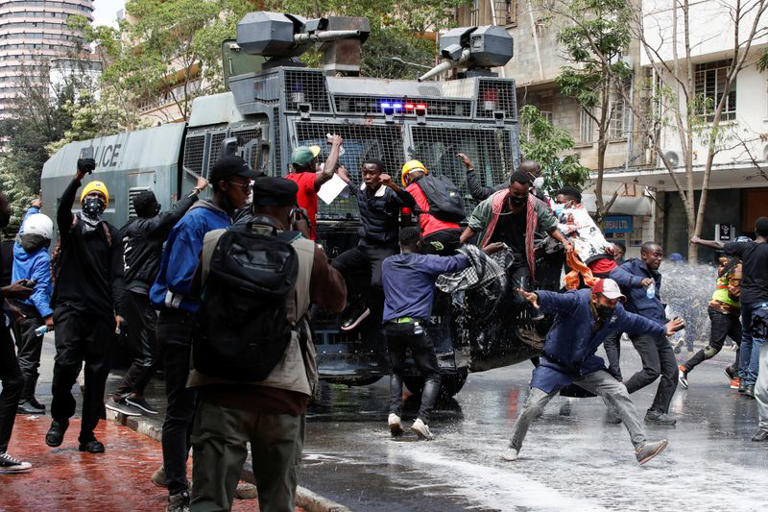The High Court’s recent directive is a significant step toward safeguarding the rights of peaceful demonstrators in Kenya. This order, issued on Friday, bars the National Police Service from using water cannons, tear gas, live ammunition, rubber bullets, and other severe measures against protestors. It also prohibits police from engaging in extrajudicial killings, unnecessary arrests, abductions, and any form of violence or harassment against those peacefully opposing the Finance Bill of 2024.
Context and Background
The Finance Bill Protests
The Finance Bill of 2024 has sparked widespread public outrage and significant protests across Kenya. Critics argue that the bill imposes burdensome taxes and economic policies that disproportionately affect the lower and middle classes. These demonstrations have drawn large crowds, united in their call for fair economic practices and a more just society.
The Role of Saitabao Ole Kanchory
Saitabao Ole Kanchory, a prominent advocate for civil liberties, filed a petition prompting the High Court’s intervention. He sued the Inspector General of Police, Japhet Koome, the Interior Cabinet Secretary, Kithure Kindiki, and the Attorney General, Justin Muturi, citing recent instances of police brutality during protests. Kanchory’s petition highlights a crucial issue: the balance between maintaining public order and respecting the constitutional rights of citizens to protest peacefully.
The Court’s Directives
Prohibition on Draconian Measures
The court’s order restricts the use of excessive force, including water cannons, tear gas, and live ammunition, which have historically been employed to disperse crowds. These measures, though often justified by authorities as necessary for maintaining order, have frequently led to injuries and even fatalities among peaceful protestors.
Ban on Extrajudicial Actions
The directive also explicitly bans extrajudicial killings, a stark reminder of the severe consequences that can arise from unchecked police power. This prohibition is a critical safeguard against the unlawful use of force that has plagued past demonstrations in Kenya.
Protection Against Harassment and Intimidation
Further, the court ordered a halt to arrests, abductions, detentions, harassment, and any form of inhumane treatment of demonstrators. This move underscores the judiciary’s commitment to protecting individuals’ rights to protest without fear of retribution or violence from state forces.
Implications for Civil Rights and Law Enforcement
Reinforcing Constitutional Rights
This ruling is a strong affirmation of the constitutional right to peaceful assembly and protest. By curbing the police’s ability to use force against non-violent demonstrators, the court is reinforcing the principles enshrined in Kenya’s constitution, particularly those concerning freedom of expression and the right to peaceful assembly.
Impact on Police Practices
For the police, this order necessitates a shift in how protests are managed. Law enforcement will need to adopt more restrained and measured approaches to crowd control, focusing on de-escalation rather than confrontation. This could lead to better community-police relations and a reduction in the incidents of violence that have marred past protests.
Broader Societal Effects
The court’s decision could have broader societal impacts, potentially encouraging more people to engage in peaceful protest without fear of violent reprisal. It sends a clear message that the judiciary is willing to protect citizens’ rights against overreach by state forces.
Moving Forward
Monitoring and Compliance
Ensuring compliance with this directive will be crucial. Civil society organizations, human rights groups, and the public will play essential roles in monitoring the police’s adherence to these orders. Mechanisms for reporting and addressing violations must be robust to hold law enforcement accountable.
Legal and Political Developments
The outcome of Kanchory’s petition, which the court will hear and determine in due course, will be pivotal. It could set a lasting precedent for how peaceful protests are handled in Kenya and potentially influence broader legal and policy frameworks regarding civil rights and police conduct.
Public Awareness and Advocacy
Raising awareness about these rights and the court’s directives is vital. Public education campaigns can inform citizens of their rights and the proper conduct they should expect from law enforcement during demonstrations. Advocacy groups must continue to push for policies and practices that uphold the principles of peaceful protest and human dignity.
Conclusion
The High Court’s order is a landmark decision in protecting the rights of peaceful demonstrators in Kenya. It underscores the importance of constitutional freedoms and sets a precedent for more humane and restrained police practices during protests. As the nation navigates the complex issues surrounding the Finance Bill of 2024, this directive offers a path forward that respects the rights of citizens to voice their concerns without fear of violence or repression.
